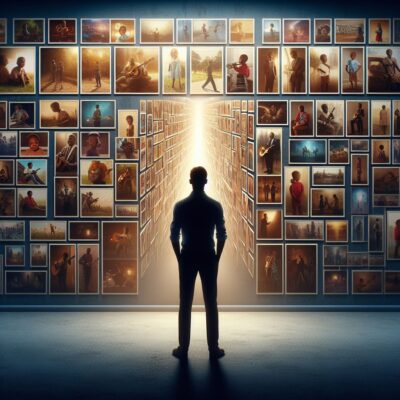Historification Therapy

— a therapeutic/educational process developed for the purpose of promoting creativity and personal growth —
(Note: The term–historification–is borrowed from Cavellini, the great Italian artist. “Self-historification” is the way he used the term. Historification Therapy is a form of self-historification.)
“It is the genius in us who knows that the past is most definitely past, and therefore, not forever sealed but forever open to creative interpretation.” — James Carse
Overview
Historification Therapy invites an interaction with one’s own history; examining and re-examining it, emphasizing or de-emphasizing specific events, extracting hidden and/or obscure meanings, coloring and casting the whole of it in a new light, all of this so that one’s history can begin to support the person one wishes to be now and in the future.
Acquiring this sort of adeptness with the past is the aim of Historification Therapy. The idea is to cultivate the art of the story-teller, the film-maker, the individual who, in William Gordon’s words, can “project a vision of the future backward on the past, re-creating that past so as to establish the desired continuity of development…” (1)
“The past does not influence me; I influence it.”
Willem de Kooning
In order for this adeptness to develop, the past must be allowed to be past. This means letting go of the anger and resentment still harbored for past events. There is no denial in this process but there is forgiveness. And the forgiveness is not so much for the benefit of others as it is for oneself.
Owen Barfield once wrote that meaning is to be found in the narrowing of the gap between creature and creator. Historification Therapy is a deliberate attempt to narrow that gap. Its purpose is to help the individual take responsibility for the authoring and directing of their own story with little in the way of excuse-making or blame. Historification Therapy is another tool—and there are many—with which to meet (as well as gain insight into) the requirements and possibilities of one’s development as a person.
“The movement into the future always involves the revisioning of the past.”
William Irwin Thompson
Procedure
The procedure is simple. First, secure a wide roll of paper (a “filmstrip”), a room and/or long tabletop to accommodate it, boxes of family photographs, yearbooks, scrapbooks, medals, memorabilia, etc. Then, while playing the soundtrack of your choice (or none at all), artfully and with care arrange the pictures and artifacts on the paper, from pictures of great-grandparents and others barely remembered, to pictures of grandparents, parents, infancy, childhood, grade school, high school, military service, college, employment, marriage, divorce, children, etc., until the characters in your story are all in front of you. To add further detail, write in addresses, moves to new locations, names of schools, streets, people, dates, formative events.
As you proceed—alone, with your family or with a therapist—the questions to consider (and to which you may want to write answers) are these:
Who is/was your mother? What did you learn from her? Who is/was your father? What did you learn from him?
Who were you when you were the person in this picture? In what way did you change by the time you were the person in this picture? What brought about the change? What was on your mind here…and here…and here? Of what did your world consist when these pictures were taken?

What did you get from this school? from this group of friends? from military service? In what ways did these various relationships (depicted in the photos) work—even though from some points of view they seemed to fail? What did you learn from this relationship with your first spouse? from this relationship with your brother, sister, child, mentor, friend?
What did you fear at this early age? And later, in adolescence, what did you fear? As a young adult? as a middle-aged man or woman? with the coming of old age?
“The truest and innermost biography of each of us, from childhood to life’s end, may well be told by detailing the successive things we have feared.” (2)

“The last fear we overcome is our belief that we cannot love creatively.” (3)
Who have been the key actors in your “film”? What, where, and when were the turning points? When, for example, did the Great Doubt enter your life, if at all? Where and under what circumstances did you act bravely? Serve the truth? Take charge of this or that situation? Where and under what circumstances did you find love? In what ways have you served others?
With every question, you are looking for the view or interpretation that emphasizes what you have gained. You are looking for the reasons you have to be grateful, teasing out the ways in which your storyline has empowered you. It may be true that your experience with a specific person was painful, even deplorable. Still, you survived. You gathered wisdom and strength. And now, with this process, you gain additional strength as you witness your ability to interpret your past in a way that supports your further development as a person.
The next step in the process is to begin sharing your story, sharing it with those who are interested. In some cases, this will mean sharing the filmstrip in its entirety. In other cases, sharing details about this or that particular episode or event. The important point, however, is to tell the story, telling it with respect, humor and openness, but most of all, and increasingly, with a loving and compassionate awareness until you find that you can accept it, conscious of the patterns and cycles but no longer caught by them; indeed, now with a growing belief in your capacity for choice and follow-through.
“As the hermeneutic and psychoanalytic models have informed us, each person or community of persons defines its identity by retelling the story of itself.” (4)
(NOTE: If this seems fanciful, this notion that by displaying your history and then telling and retelling your story that you can begin to liberate yourself from harmful aspects of it, then consider that this is standard therapeutic practice. Objectify the issue. Make it visible. And while standing apart from it, extract the many meanings and interpretations available until you find the storyline with which you are comfortable, perhaps even pleased because it now seems to lead to a person capable of moving forward, no longer stuck or encumbered as perhaps was thought.)
In time, the value implicit in sharing your story diminishes. From that point—and this has been the aim all along—the focus is on living and proceeding more often as you, yourself, choose. This is the fruit of the labor: To interact more often in accord with dreams perhaps shelved for too long. No longer encumbered to the same degree.
Norman Maclean wrote that it is “almost impossible…to quit a story once you have become a character in it.”(5) This, however, is the purpose of Historification Therapy: To help the individual quit a destructive story, to help loosen the hold that an unhappy or destructive story can have.
To put it another way, Historification Therapy is a way of changing the story, not the events that comprise it but how they are seen, interpreted. The underlying assumption is that for each of us, an actualization story is being written. It may or may not be easy to find but it is there, perhaps hidden, perhaps in plain sight. When discovered, it brings with it additional degrees of freedom, a greater capacity to depart from troubling patterns. Historification Therapy is one of many processes designed to help individuals find their way to conduct consistent with their aspirations as opposed to conduct dictated, seemingly, by a harsh or indifferent past.
AI images: “interpreting/detecting/seeing degrees of freedom”
Postscript One
One additional element of Historification Therapy is worth mentioning. It concerns the impact of the filmstrip itself. When viewing it, one cannot help but be struck by the way in which the filmstrip reveals the time through which one has lived. Invariably, the filmstrip moves from weathered, yellowed, faded black and white photographs…to sharper black and white…to the first appearance of color…to vivid color…to Polaroid…to 3D… as the evolution of technology marks the time as well as the story of one’s life.
Postscript Two
According to my records, the first Historification Therapy client was in 1984. At the time, I was not aware of any other process resembling it. In 1995, Newsweek magazine published an article on “narrative therapy” (“Rewriting Life Stories”, April 17, 1995). It was the first time I had heard the term, or that I was aware of other therapeutic processes similar to Historification Therapy. According to the article, “the narrative movement was launched in the late 1980s…its adherents primarily in Australia, New Zealand, and North America.”
David Thomas, PhD
Dedication
Historification Therapy is dedicated to Donald Mayberger, an American historification artist.
References
(1) The Mind and Art of Henry Miller by William A. Gordon
(2) Review of Landscapes of Fear by Yi-fu Tuan; by Alan Lacy
(3) Creative Transformation by John David Garcia
(4) The Wake of Imagination by Richard Kearney
(5) A River Runs Through It by Norman Maclean.
“…and history is an impertinence and an injury if it be any thing more than a cheerful apologue or parable of my being and becoming.” — Ralph Waldo Emerson, “Self-Reliance”










